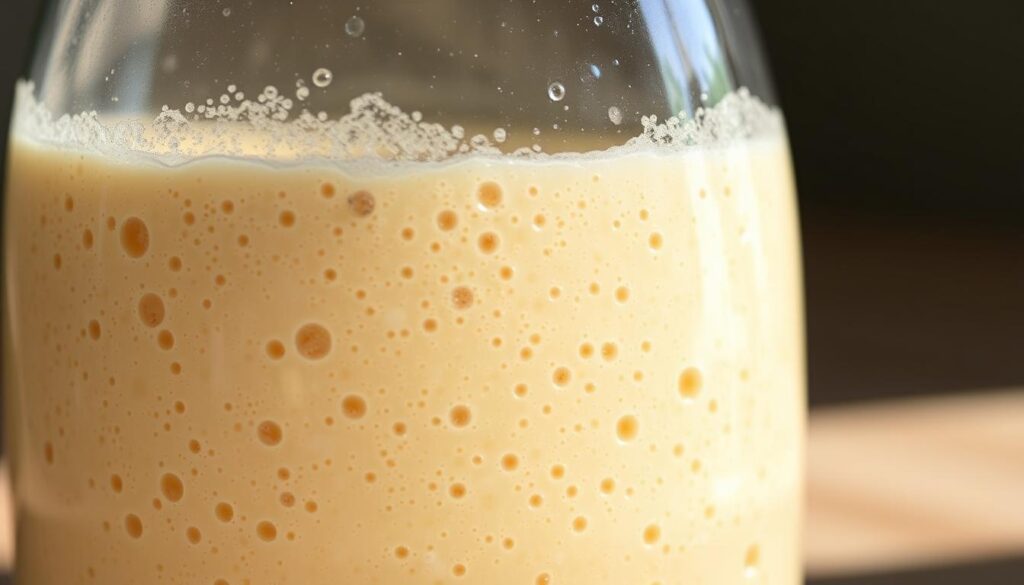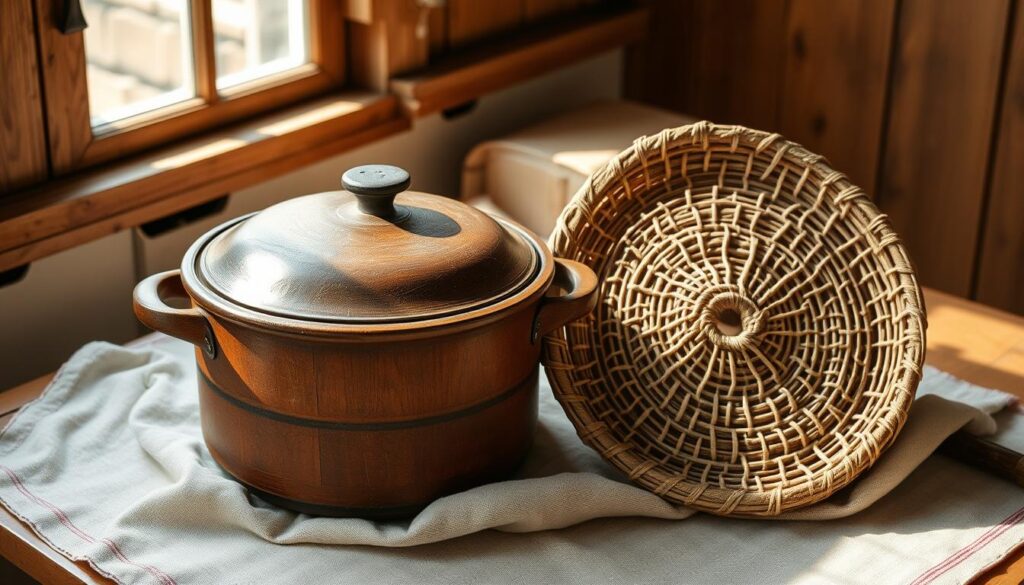Ever wondered why bakers love making batard bread so much? This French-style loaf has a crispy crust and a soft inside. It’s a favorite among bread lovers. In this guide, you’ll learn how to make perfect batard bread, whether you’re new or experienced.
You’ll find out about the key ingredients and the role of a sourdough starter. We’ll also share important techniques. These will help you make amazing bread at home.
We’ll cover the science behind batard bread and how to avoid common mistakes. With ingredients like bread flour, water, salt, and sourdough starter, you’re ready to bake. Let’s explore the world of batard bread and discover new baking techniques together!
Table of Contents
Key Takeaways
- Batard bread is made with just four ingredients: bread flour, water, salt, and sourdough starter.
- The best water temperature for fermentation is about 70°F.
- A Dutch oven between 4 to 7 quarts is perfect for baking.
- Bake for 25 minutes with the lid on, then 20 minutes without.
- Cool the loaf for at least an hour before slicing to avoid a gummy texture.
What is Batard Bread?
Batard bread is a classic French bread known for its oval shape and soft, chewy texture. It’s usually 6 to 12 inches long and 4 to 6 inches wide. This makes it perfect for sandwiches or as a side for spreads.
The name “batard” means “bastard” in English, hinting at its unique shape. What’s special about batard bread is its mix of a crispy outside and a soft, tasty inside. This comes from using a sourdough starter, which adds to its flavor and texture.
When making batard bread, you’ll need about 500 grams of bread flour and 320 grams of water. This gives it a hydration ratio of 64%. Adding 2 ¼ teaspoons of active dry yeast helps it rise well.
Making batard bread is a fun project for anyone. For more recipes and ideas, check out this delicious link. You can use it in cookies, pastries, or just enjoy it with a meal. Batard bread opens up endless possibilities in the kitchen.

The Importance of a Sourdough Starter
A sourdough starter is key to making delicious homemade batard bread. It uses a slow fermentation to create tasty flavors and a soft texture. Making your own starter can make baking more fun and rewarding.
How to Make Your Own Sourdough Starter
To make a sourdough starter, mix equal parts of flour and water in a clean container. Bread flour works best because it has more protein, helping it ferment better. Let it sit at room temperature for 5 to 7 days, feeding it daily.
As you feed it, you’ll see bubbles, showing it’s alive and ready for baking. A healthy starter is vital for great homemade batard bread.
Feeding and Maintaining Your Sourdough Starter
Feeding your starter regularly keeps it healthy and active. Do this every 1 to 3 weeks by throwing away half and adding fresh flour and water. The right mix is important; for example, 25g of starter with 50g of flour and 50g of water makes a strong levain.
With proper care, your starter will give your batard bread its unique tangy taste and rise. This makes the bread even more enjoyable to eat.

| Activity | Time Required |
|---|---|
| Making the starter | 5 to 7 days for active starter |
| Levain building | 8 to 12 hours |
| Feeding sourdough | Daily or every 1 to 3 weeks |
| Baking with starter | Varies depending on the recipe |
Essential Ingredients for a Batard Bread Recipe
Baking a delicious batard bread needs careful ingredient selection. The quality and type of ingredients are key to a great loaf. Knowing what your dough needs is crucial for the best results, especially in artisan baking.
Choosing the Right Flour: Bread Flour vs. All-Purpose
Choosing the right flour is crucial for the perfect batard bread texture. Bread flour, with more protein, helps the dough rise better than all-purpose flour. This makes it the top choice for bakers who want a light, airy bread.
For a classic batard, mixing whole wheat flour with bread flour is a good idea. It keeps the dough hydrated just right.
The Role of Water and Salt in Bread Making
Water quality greatly affects your bread’s taste. Using filtered water can make your bread taste richer. Salt is also vital; it enhances flavor and helps the yeast work better, making the dough stronger.
These basic ingredients are the base of any successful bread-making project.
| Ingredient | Type | Recommended Amount |
|---|---|---|
| Bread Flour | High-protein | 800 grams |
| Whole Wheat Flour | Optional | 200 grams |
| Water | Filtered | 560 grams |
| Salt | Fine | 15 grams |
| Instant Yeast | Active | 3 grams |

Equipment Needed for Baking Batard Bread
Getting the right tools is key when baking batard bread. The right equipment helps shape and bake your bread perfectly. It ensures a crispy crust and a beautiful look.
Choosing the Right Dutch Oven
A heavy cast iron Dutch oven is perfect for baking batard bread. It traps steam, which is vital for a crispy crust. Make sure the Dutch oven fits your batard without being too tight. Brands like Le Creuset and Lodge are great for home bakers.
Understanding the Use of Banneton Baskets
A banneton basket is crucial for shaping your dough during proofing. It gives your bread its classic shape and adds beautiful patterns to the crust. These baskets help remove moisture, allowing your dough to develop properly.

| Equipment | Benefits | Popular Brands | Price Range |
|---|---|---|---|
| Dutch Oven | Traps steam for crispy crust | Le Creuset, Lodge | $60 – $300 |
| Banneton Basket | Shapes dough and enhances appearance | Breadtopia, USA Pan | $15 – $40 |
Using these specific tools will greatly improve your batard baking. They are essential for the right texture, structure, and flavor of your sourdough.
The Batard Bread Process
Learning the batard baking process is key to making a great artisan loaf. It starts with a sourdough starter, which adds flavor and rise. Mixing quality ingredients like flour, water, and salt is crucial for the dough’s structure.
The dough ferments for 2-3 hours at room temperature. This step develops its flavor and structure. Alternatively, a longer rise in the fridge can make the bread even more complex. During this time, gently stretching and folding the dough makes it strong and ready for shaping.
After the bulk rise, the dough is pre-shaped into a loose round. It rests for 30-40 minutes. Then, it’s shaped into the batard form, a unique oblong loaf. The right taper at each end is important for the bread’s look and structure.
The proofing stage is critical. It allows the batard to rise one last time before baking. A 14-inch proofing basket is perfect for a 900-gram dough. After about an hour, the dough will have doubled in size, ready for the oven.
For the best crust, bake at 480°F for the first 15 minutes. Then, reduce the temperature to 450°F for another 10 minutes. Scoring the dough at least half an inch deep is key for expansion and a beautiful finish.
Every step in the batard bread process is important for a crispy crust and soft interior. By mastering these techniques, you’ll make delicious batard bread that shows off your artisan skills.
Step-by-Step Batard Bread Recipe
Baking batard bread needs careful attention, especially at the start. Follow these steps to get a delicious loaf with great texture. First, mix the dough with these ingredients:
- 500 g Bread Flour
- 350 g Water
- 100 g Sourdough Starter
- 10 g Salt
Put these together in a bowl and let it rest for about an hour. This step, called autolyse, makes the flour absorb water. After resting, add the salt and knead until the dough is smooth and elastic. Aim for a 70% hydration level for the best results.
Prepping the Dough
During the prep phase, do multiple stretching and folding sets. Do four to six sets with 15-minute breaks in between. Watch the dough as it ferments; it should double in size and feel airy.
Expect fermentation to take 5 hours to 36 hours in the fridge, depending on flavor and texture. For other bread types, check out this bread rolls recipe.
Shaping and Proofing the Batard
After fermentation, turn the dough onto a floured surface. Shape it into an oval, or batard, with tension on the surface. This method makes the inside open, perfect for sandwiches.
If the dough is too elastic, rest it for 10 more minutes before shaping. Then, put the dough in a banneton for proofing. The banneton should fit your Dutch oven. Cover it with a cloth to keep moisture in.
Proof for at least 5 hours at room temperature, or refrigerate for 12 to 24 hours for more flavor.
Batard Bread Baking Tips for Perfect Results
Baking batard bread is a journey to tasty and satisfying results. To get the best, follow some key baking tips. Paying attention to the crust and using the right scoring techniques are crucial.
Achieving the Perfect Crust
For a crunchy crust, preheat your Dutch oven well. This traps steam, making the crust crisp and appealing. Bake at 480°F for 15 minutes to get the crust right.
Then, lower the heat to 450°F for another ten minutes. This ensures your loaf is perfectly baked.
Understanding Oven Spring and Scoring Techniques
Scoring is key for the bread to expand right. Use a sharp blade or lame for this. A single, deep score helps the loaf rise, making it look and taste better.
A good score also keeps the crust beautiful and intact. For more ideas, check out this resource on bread making. Keep practicing to get a stunning batard every time.
Delicious Batard Bread Variations to Try
Exploring batard bread variations can be exciting. You can try new flavors and textures by adding different ingredients. Herbs and cheese make the bread savory, while sweet ingredients add a unique twist.
Adding Herbs and Cheese
For a savory treat, add herbs and cheese to your dough. Popular choices include:
- Rosemary: A fragrant herb that pairs beautifully with a variety of cheeses.
- Garlic: Adding roasted garlic can impart a strong flavor that complements many cheeses.
- Cheddar: This cheese melts well and contributes a sharp flavor that enhances the overall taste.
These ingredients not only elevate the taste but also make the loaf visually appealing. It’s perfect for any gathering.
Creating Sweet Batard Flavors with Fruits
Sweet batard variations are great for breakfast or dessert. To create these sweet flavors, consider adding:
- Dried fruits: Raisins, apricots, or cranberries can add a chewy texture and natural sweetness.
- Chocolate chips: A decadent add-in that can take your batard to a whole new level.
- Honey or maple syrup: A drizzle in the dough can enhance the sweetness organically.
These creative batard bread variations showcase your ability to innovate while baking. They make for a memorable dining experience.
| Ingredient | Function | Suggested Amount |
|---|---|---|
| Fresh Herbs | Adds flavor and aroma | 1-2 tablespoons |
| Cheese | Offers richness and enhances taste | 1 cup, shredded |
| Dried Fruits | Sweetens and adds texture | 1 cup |
| Chocolate Chips | Provides a sweet burst of flavor | ½ cup |
The Science Behind Batard Bread Baking
Baking batard bread is more than just cooking. It’s a science that involves the fermentation process. This process uses natural yeast from your sourdough starter to break down sugars in the dough. It changes the flavor and helps the dough rise by creating carbon dioxide bubbles.
Gluten development is also key. It happens during kneading. This step activates gluten proteins, making the dough strong enough to hold the fermentation gases. This leads to the bread’s light and fluffy texture.
When baking batard bread, paying close attention to details is crucial. Keeping the fermentation temperature between 78° to 82°F is important. This temperature range is ideal for fermentation, which usually takes 3 to 4 hours.
Understanding how hydration levels and kneading techniques affect gluten development is essential. It helps you achieve consistent results. Watching how dough reacts to different conditions helps you grasp the science behind making delicious bread.
Common Mistakes to Avoid When Making Batard Bread
Avoiding common mistakes making batard bread can greatly improve your baking. Over-fermenting the dough makes it dense and gummy. On the other hand, not kneading enough can weaken the gluten, affecting the bread’s quality.
Using the right kneading techniques, like the slap and fold, can strengthen the dough. Scoring the dough is also crucial. It helps the bread expand evenly in the oven and creates a nice crust.
Pay close attention to each step of the process. A dough that springs back slowly when poked is ready. This shows it has fermented well.
Keep an eye on how long your dough proofs. Warm proofing takes 1.5 to 3 hours. Fridge proofing is best for 8 to 12 hours to avoid crust formation. Cold proofing enhances flavors but can make the bread too sour if it goes too long.
Use the poke test to check if your dough is proofed right. If it springs back slowly, it’s ready. Too quick means it’s not proofed enough. Not bouncing back means it’s overproofed.
For more tips on fixing dough problems, see this sourdough troubleshooting guide.
With the right knowledge, you can avoid these common mistakes. By mastering your techniques and understanding the science, you’ll make a batard bread that’s both delicious and impressive.
Conclusion
Baking batard bread is a rewarding journey that can improve your cooking skills. By learning the key parts of the recipe, you can make delicious loaves. These loaves will impress anyone who tries them.
As you bake, try new ingredients like whole grains and different flours. This will make your loaves even better. Paying close attention to details like hydration and temperature will lead to exciting results.
So, get your baking supplies ready and start exploring the world of batard bread flavors. Enjoy the process and remember, every loaf has a story to tell. Happy baking! For more recipe ideas, visit this link.
F.A.Q
What is batard bread?
Batard bread is a French loaf with an oval shape. It has a crispy crust and a soft inside. It’s like a baguette but shorter and thicker, perfect for sandwiches or spreads.
How can I make my own sourdough starter?
Mix equal parts bread flour and water to start your sourdough. Let it sit at room temperature until it’s bubbly. Feed it every 1-3 weeks to keep it alive.
What ingredients do I need for a batard bread recipe?
You’ll need high-protein bread flour, filtered water, and salt. These are the basics for your homemade loaf.
What equipment do I need for baking batard bread?
Use a heavy cast iron Dutch oven for steam and a crispy crust. A banneton basket shapes the dough, making your batard look great.
How do I shape and proof my batard?
Shape the dough into an oblong form for a batard. Proof it in a banneton basket in the fridge for 12-24 hours. This improves flavor and texture.
What are some tips for achieving the perfect crust?
Preheat your Dutch oven before baking. Score the bread to let it spring. This boosts volume and texture.
Can I add flavors to my batard bread?
Yes! Try herbs, spices, or cheese for savory flavors. Or add dried fruits or chocolate chips for sweetness. These make your batard special.
What common mistakes should I avoid when making batard bread?
Avoid over-fermenting or under-kneading. These can ruin the texture. Also, scoring the dough is key for a good appearance.
How can I ensure my sourdough starter is healthy?
Feed your starter regularly to keep it bubbly. Use filtered water and store it at room temperature. This keeps it healthy for baking.
What makes batard bread different from other types of French bread?
Batard bread is shorter and thicker than a baguette. Its shape, flavorful inside, and crisp outside make it unique.



